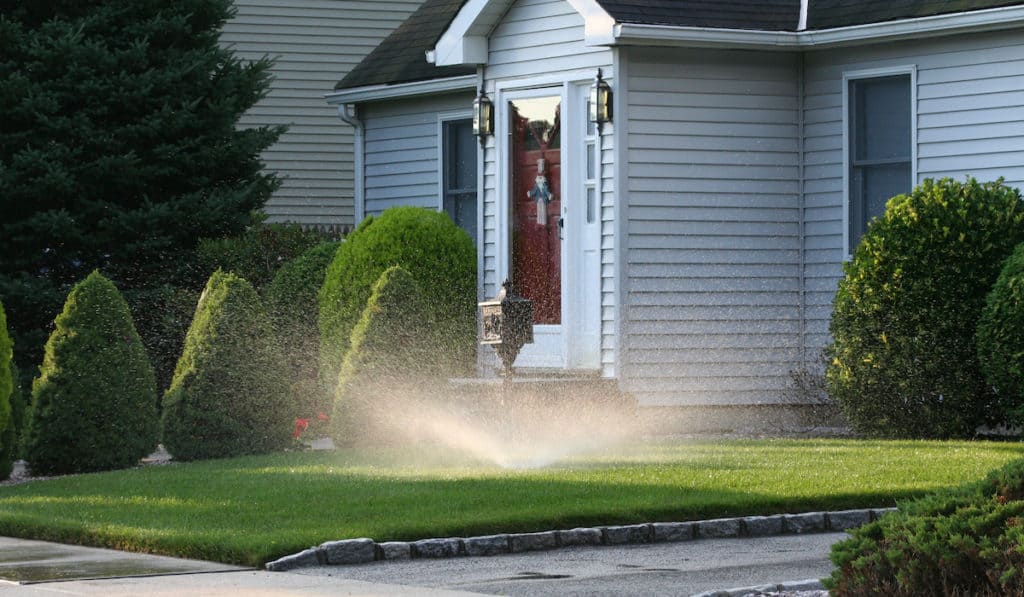Making informed decisions helps you save money in the long run, especially if you’re in the market for high-efficiency irrigation systems. For instance, knowing how much electricity sprinkler and drip irrigation systems use can help you account for future expenses. So, how much electricity does an irrigation system use?
An irrigation system uses 0.59 kWh/m3 (730 kWh/ac-ft) of electricity. Factors such as the power and efficiency of the pump, lifting the water to the surface, required water pressure, component wears, and leaks influence how much electricity the irrigation system uses.
Today, you’ll learn about how much electricity sprinkler and drip irrigation systems use and the factors influencing how much energy they require. Also, you’ll pick up formulas that you can use to calculate the energy requirements of sprinkler and drip irrigation systems.
What Are the Energy Requirements of an Irrigation System?
Understanding the energy requirements for your irrigation system can help save hundreds, if not thousands, of dollars every year.
The average energy requirements of an irrigation system is 0.59 kWh/m3 (730 kWh/ac-ft). Pump power and efficiency, required water pressure, and vertical lift determines how much electricity these systems use. Component wear and leaks in the system can increase energy usage while reducing efficiency.
However, the energy requirement varies depending on whether you want to use the irrigation system for domestic use. For instance, watering your kitchen garden, greenhouse, and backyard garden isn’t as resource-intensive as maintaining a 1-acre (4046.86 m2) farm.
Factors Influencing Energy Costs of an Irrigation System
Let’s break down the factors determining how much you’ll spend every month on your energy bills.
1. Pump Power and Efficiency
The power rating of the pump is how much force the device has to move water from one location to another. In the U.S., horsepower (hp) is the standard unit of measurement for power. Generally, pumps with high horsepower consume greater amounts of electricity to operate.
Next is how efficiently the pump converts electricity to move the water for irrigation. An ideal system will have 100% efficiency. However, in the real world, the pump has to overcome friction.
Also, if you observe a working pump, you’ll notice it produces heat and noise. According to the second law of thermodynamics, energy can change from one form to another, but it can neither be created nor destroyed.
Following this law, some of the heat (energy) and noise (energy) generated come from electricity (energy).
2. Vertical Lift
The pump of an irrigation system has to draw water from the source and move it to its surface. This distance between the two is known as lift —the greater the lift, the more work the pump has to do while operating. And, the more work the pump has to do, the more money you’ll be spending.
3. Water Pressure
Suppose there isn’t sufficient pressure in the irrigation system. In that case, it results in wastage of water, increasing energy costs.
For example, high water pressure in sprinklers can result in misting. As the water droplets are tiny, they evaporate quickly. Also, winds can push them further away, causing significant water loss.
In this case, the pump will need more water than usual for irrigation, increasing its energy requirements.
4. Component Wear
Component wear is natural due to the presence of impurities in water. Due to the water pressure in the system, these impurities erode various parts of the pump, decreasing its efficiency. The less efficient the irrigation system is, the more money you’ll be spending without results.
5. Leaks
Unfortunately, leaks are a problem that irrigation systems may face.
Leaks in the irrigation system increase the water volume required to irrigate the land, resulting in wastage. Therefore, you’re still paying for the same amount of water, but your system is actually supplying less, leading to high expenses with less results to show for it.
How Much Does a Sprinkler System Use?

A sprinkler system uses around 0.5 kWh of electricity a day, depending on the area size, amount of power, and amount of time used. For example, the amount of electricity used for commercial sites will be significantly higher than for residential, due to size, electrical power needed, and more use.
In the sections below, I’ll discuss how to calculate the electricity used for sprinkler irrigation systems, and go over which type of system is best for you.
Calculating Drip and Sprinkler Irrigation Electricity Usage
As highlighted above, several factors influence how much energy an irrigation system requires.
If you want to find out how much electricity drip or sprinkler irrigation will use, you need to consider the following factors:
1. How Much Power the Irrigation System Will Use
Most manufacturers will print how much power the irrigation system will use during operation. If you cannot find this information, a simple search online should give you all the necessary details.
Another way to calculate the electrical power of any appliance is with this formula —
P = V x I.
P is power (measured in watts), V is voltage (measured in volts), and I is current (measured in ampere). The manufacturer will use ‘V’ to indicate the appliance’s voltage and ‘A’ for current.
E.g., If a pump uses 120 volts and 2 amperes, the power of this system is — 120 V x 2 A = 240 W.
2. The Amount of Time You Use the Irrigation System
How long do you plan on using the irrigation system throughout the day? Remember, you need to account for the size of the area you want to water. The larger the site, the more time it’ll take for irrigation.
Once you know the power and time requirements, it’s quite simple to calculate how much electricity the irrigation system will use.
Electrical consumption = Power x Time
Let’s assume you’re using the irrigation system for four hours daily, and its power rating is 240W.
Electrical consumption per day = 240 W x 4 h = 960 Wh
Energy companies measure electrical consumption in kilowatt-hours. Divide the above figure by 1000.
Electrical consumption in kWh = Power in kW ÷ 1000
960Wh ÷ 1000 = 0.96 kWh
To calculate how much it’ll cost, multiply the electrical consumption with the cost per kWh in your area.
Cost of irrigation per day = Electrical consumption in kWh x cost per kWh
Let’s assume it’s 15 cents per kWh.
Cost of irrigation per day = 0.96 kWh x $0.15 = $0.144 per day.
If you need to know the yearly cost, you can multiply the cost of irrigation per day with the number of days you’ve to operate the system.
Yearly irrigation cost = cost of irrigation per day x number of operating days
In this case, let’s say you only need to use the irrigation system for 200 days.
Yearly irrigation cost = $0.144 x 200 = $28.8 a year.
Is There a Difference to a Drip Irrigation System?

You now know how to calculate how much electricity each irrigation system will consume. But, is there a difference to a drip irrigation system? Let’s dive into which one is better in terms of power consumption.
There is a difference to a drip irrigation system. Drip irrigation reduces energy consumption by 50%. Its vertical lift and pressure requirements are low in comparison to sprinkler irrigation. Focused water delivery of drip irrigation also reduces its energy consumption.
The Natural Resources Conservation Service (NRCS) Irrigation Guide explains drip irrigation and its benefits.
However, this doesn’t always mean drip irrigation is the best option. Use the following factors to decide on which irrigation system you should choose:
- Availability of water.
- Climate and soil conditions.
- Energy and equipment costs.
- Plants you want to grow.
If you want to find out how much energy each irrigation system consumes, use this energy estimator from NRCS.
Conclusion
The average electricity consumption of an irrigation system is 0.59 kWh/m3 (730 kWh/ac-ft). Many factors affect the energy these systems require, including:
- Pump power and efficiency.
- Vertical lift.
- Water pressure.
- Component wear.
- Leaks.
Regarding energy consumption, drip irrigation offers better value than sprinkler irrigation.

